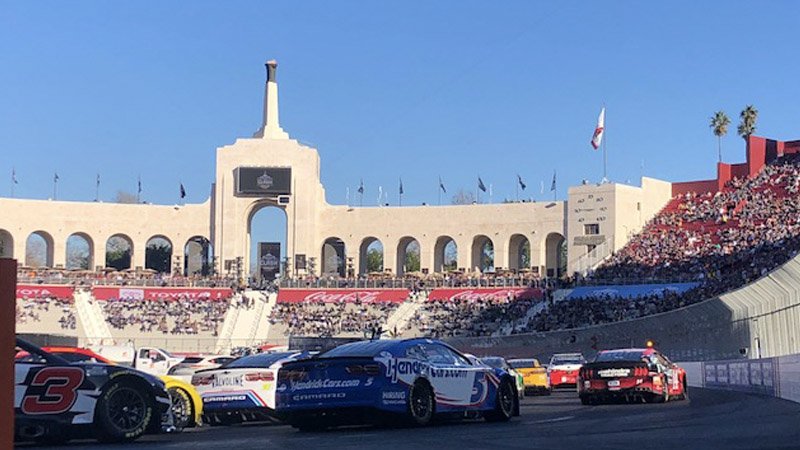With three PGA Tour events in three weeks, the Super Bowl and the former Golf Industry Show, who knew one of the most exciting things to happen in California in a month would be an exhibition car race? And who knew it could provide a learning moment for other sports, including golf?
In searching for a way to infuse interest and energy into a sport where both have been on the wane, NASCAR did not just tiptoe down the steps into the shallow end of the pool when it held a stock car race inside the Los Angeles Memorial Coliseum on Feb. 6, it did a cannonball off the high dive that ended with a glorious splash.
The Busch Light Clash at the Coliseum, which showcased NASCAR drivers navigating 150 laps around a short quarter-mile track stuffed into a football stadium and leaned on live entertainment during a mid-race break, was a daring and aggressive attempt to gain traction by introducing the sport to new and under-represented audiences - namely minorities and those under 30.
The event illustrates an attempt by an entire sport to expand its customer base by combining entertainment with its core business.
Although this is no endorsement of concerts at PGA Tour events, cramming a race into a football stadium with live entertainment illustrates an attempt by the sport to expand its customer base by infusing its core business with something new and different. It is a lesson some sports, including golf, have learned from in one way or another. And if the numbers are any indication, it could be a valuable lesson.
Since enjoying record popularity in 2005, NASCAR's appeal has been on a steady slide followed by an upward tick in 2021.
Sound familiar?
The LA Coliseum is not the first NASCAR facility to bring an event like a concert to the track.
Declining attendance during the past 17 years resulted in reactions like lowering seating capacity, a practice NASCAR called “right-sizing.” On an individual track level, some facilities implemented a value-added experience, such as a pre-race concert, and those are the tracks that saw better attendance through bleak times.
That was the case at the Coliseum.
The Busch Light Clash is an exhibition race that historically has been held at Daytona International Speedway where it preceded the season-opening Daytona 500. It was moved this year to the Coliseum in LA in an attempt to drive interest in the nation's second-largest metropolitan area.
NASCAR officials were so sure their experiment would be a success they were willing to spend more than $1 million on building an asphalt track for one race only to begin tearing it out the day after the event.

Attendance was about 50,000 and 4.3 million more watched the race from home. That is way up from last year's event at Daytona that drew 20,000 in attendance and Those statistics dwarf last year's numbers that included 20,000 in-person viewers and 1.7 watching on TV.
The publication Autoweek called the event "spectacular," and retired driver Tony Stewart, who was in the broadcast booth said "NASCAR didn't just open the door, they kicked it down. This is how you promote an event."
The event illustrates an attempt by an entire sport to expand its customer base by combining entertainment with its core business.
Although concerts do not necessarily have a place in golf - other than the night before The Masters - the game's stakeholders have to be concerned about adding value for the 21 million who plunk down their hard-earned money to carry the industry.
Owners and operators, at daily fee operations, have tried a variety of things to attract new blood to the course with varying degrees of success.
Owners and operators, at daily fee operations, have tried a variety of things to attract new blood to the course with varying degrees of success, such as social events, loose restrictions on music and attire, fringe activities such as FootGolf and alternatives to 18- or 9-hole rounds.
Another such example has been the advent of golf entertainment facilities like Topgolf. Such facilities are gaining in popularity because they offer a unique experience that includes much more than just golf. A decade ago, there were 10 Topgolf facilities nationwide. Today, more than 25 million people per year patronize 68 Topgolf locations open nationwide with eight more on the way. The question has been whether participation at such facilities translate into play on the golf course. We might learn the answer to that soon enough with a new facility set to open soon in Los Angeles that is part of a complex that includes the Lakes Course at El Segundo, a municipal layout in Los Angeles County.
From 2005 to 2019, rounds played dropped from 518 million to 432 million, and the number of people playing the game dropped by 10 million since 2002.
During the past two years, the golf business has been successful at regaining some of the players and all of the rounds it lost during a decade-and-a-half of industry decline. More than 20 million golfers played a record 518 million rounds in 2021. Since Covid, about 900,000 newcomers took up the game in 2020.
That growth has been attributed mostly to people seeking an outlet for recreation in a post-pandemic economy. Although there are plenty of newcomers to the game, baby boomers are still playing most of the rounds. With that in mind, operators must continue to find ways through added value to appeal to new audiences and retain those who come through the door for the first time or risk squandering all those new players and increased play , because as NASCAR has shown, sometimes the main event alone is not enough.

